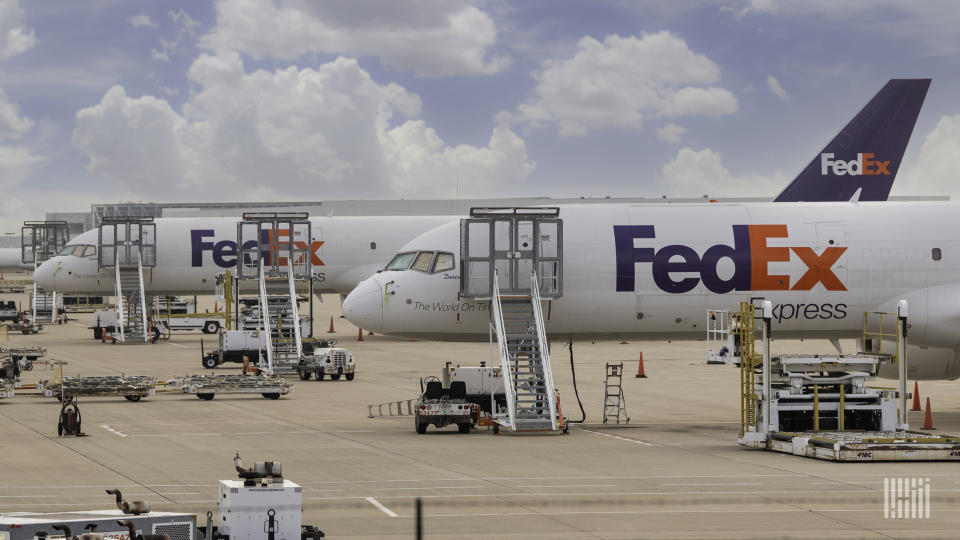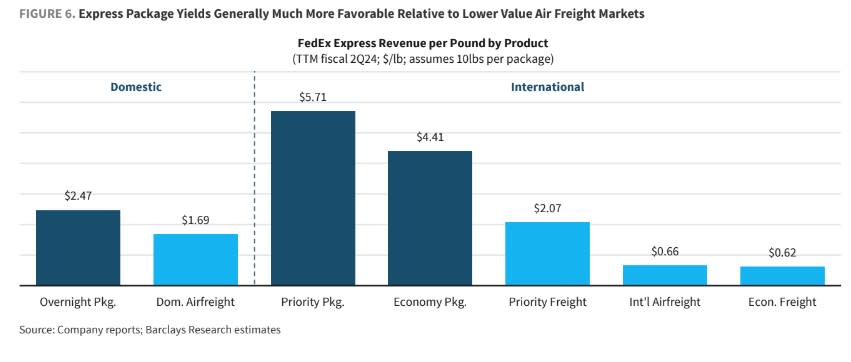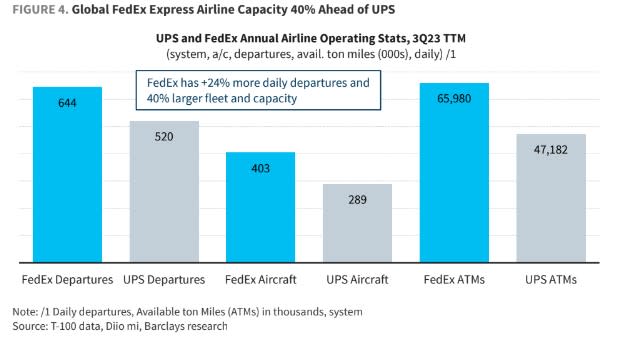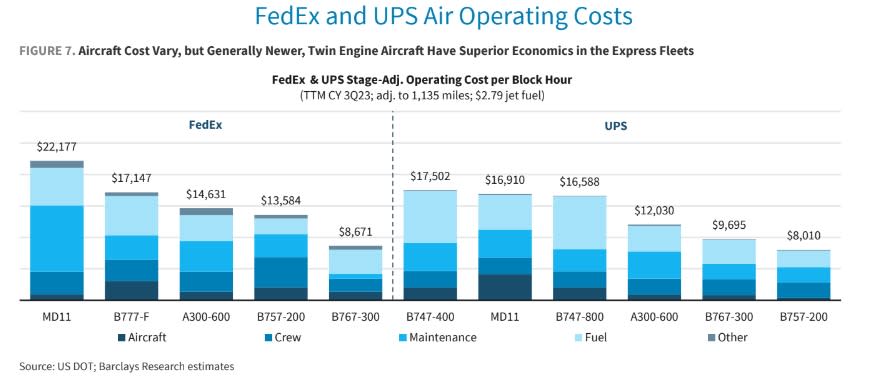How FedEx could win by losing its Postal Service business

FedEx would benefit from the partial, or complete, loss of its huge contract with the U.S. Postal Service because it would force the parcel delivery giant to downsize a bloated and expensive air transport network, which could help revive profitability, said Brandon Oglenski, who covers the company for Barclays Bank.
FedEx Express (NYSE: FDX) and UPS (NYSE: UPS) move similar quantities of domestic and international express packages, but because FedEx has a much bigger airline, it chases low-yielding general cargo to fill excess capacity, contributing to lower earnings than investors have expected in recent years, according to the senior transportation and logistics analyst.
As part of a $4 billion cost campaign and initiative to consolidate portions of its Express, Ground and Freight networks, management recently outlined a three-pronged approach for driving aircraft density that doubles down on dedicating aircraft for deferred freight. The new strategy, dubbed Tricolor, is designed to segregate priority overnight parcels from slower freight to keep sort centers more fluid and lower expenses.
“FedEx’s new Tricolor initiative muddies the water, making it less clear how much air capacity and cost the company will reduce. Nonetheless, we view potential cessation of USPS flying or a renegotiated contract as driving earnings upside for FedEx,” Oglenski said in a recent client report. “We see FedEx as potentially able to cut 50% of daytime network capacity if the USPS contract is not renewed, which we estimate could save the company $1.5 billion.
“UPS operates a much smaller daytime air operation, effectively only flying aircraft where two-to-three day service commitments cannot be achieved by truck. We believe a similar footprint at FedEx could be accretive to earnings, as the company would not be trying to sell expensive air capacity into truck dominated linehaul markets.”
Postal business becomes a burden
A majority of FedEx Express’ air network is geared to daytime flying for the Postal Service. Over nearly a quarter-century, the Postal Service has grown into FedEx’s largest customer. Conversely, FedEx has been the largest provider of air transportation capacity to the Postal Service for 20 consecutive years, according to data compiled by David Hendel, a transportation attorney at Culhane Meadows. But under a streamlining initiative four years ago, the agency decided to use less air transportation and rely more on cheaper ground carriers, which is eating into FedEx Express volumes distributed via its Memphis, Tennessee, hub.
FedEx’s revenue from its Postal Service contract in the fiscal year ending Sept. 30, 2022, fell $236 million to $1.9 billion and is expected to decrease again in Hendel’s next list. Postal business represents 4% of total and 10% of domestic Express revenue at FedEx. The contract previously generated annual revenue of at least $2 billion.
FedEx devotes about 100 aircraft to carry postal business at an annual cost of about $3 billion, according to Oglenski’s research. In its December earnings report, the company identified the Postal Service contract as a $400 million drag on earnings. The Priority Mail packages that FedEx primarily hauls have a similar service (two to three days) and pricing profile to packages moved by ground transport, which translates to lower yields and margins when using air transport.

FedEx officials privately acknowledge that the Postal Service contract is barely profitable. Minimum service requirements have forced FedEx to commit expensive plane capacity to relatively low-yielding parcel volume.
Pat DiMento, FedEx’s vice president of flight operations and training, recently told a group of airline employees that the postal contract led to network inefficiencies as FedEx accommodated increases in mail volumes while priority flying at night stayed the same, according to audio of the private meeting obtained by FreightWaves. A route from Raleigh, North Carolina, to Memphis, for example, might only require a small jet for overnight delivery, but FedEx will upsize to a larger freighter to meet the daytime mail requirement.
FedEx is likely to lose 50% of its daytime flying with the Postal Service, he speculated.
UPS air network is leaner
Largely due to the Postal Service business, domestic air operations are much larger at Fed Express than at UPS despite their having a similar share of the high-yielding express package market.
FedEx’s mainline fleet is 43% larger than UPS’ — 418 to 292 aircraft, according to company fact sheets. The company operates 24% more flights and has 40% more capacity than its rival, resulting in annual airline operating expenses of $18 billion compared to $8 billion at UPS, Oglenski estimated. (He acknowledged the figures are skewed a bit because FedEx tends to allocate a greater share of parcel network costs in the airline to the income statement than does UPS.)

The Barclays analyst said air assets with high fixed costs are justified for express networks. They depend on highly orchestrated operations with precision scheduling to meet demanding service expectations, and carriers can charge a significant premium above standard transportation.
While FedEx generates $6 billion more global airfreight revenue than UPS, overreliance on the air network has suppressed operating profits for a long time, Oglenski argued.
Under the Tricolor strategy, however, FedEx also intends to aggressively go after heavyweight cargo booked by logistics providers to offset slower growth in the main Express product and declining postal business. Executives announced that the fleet will be reallocated to the so-called Orange network, which will operate off-schedule to carry heavy freight that doesn’t require maximum speed and is better suited for a truck-fly-truck delivery model than flying the entire trip. These planes will fly into primary and regional sortation centers such as Newark, New Jersey, and Oakland, California, during the daytime when workers have more time to build dense pallets. The idea is that by segregating parcels and freight, the hub facilities will operate more efficiently because the two shipment types are processed differently.
Although management has publicly discussed shrinking the freighter fleet in line with lower demand, DiMento said the new strategy is aimed at shippers with both parcel and freight needs that like using a single service provider when possible.
“If we don’t capture some of that middle band, we will never get their [shippers’] freight that is also in the priority range. Right now, we don’t offer much in that middle band to save money for these companies. So they are trying to capture that so that we can also grow what is our priority, international business,” he said in the private meeting.
Management pushed back on the characterization that the company is going after general cargo, saying the Orange network will function as an extension of the carrier’s shared truckload networks around the world.
Tricolor “expands FedEx’s offerings across the globe for freight shipments which have similar characteristics to less-than-truckload vs. the much heavier and lower yield per-pound consignments which are the provenance of traditional all-cargo carriers,” Richard Smith, president and CEO of airline and international at FedEx Express, said in a letter to FreightWaves. “In addition to international LTL shipments, the Orange network handles International Economy packages that similarly interface with FedEx’s global ground parcel systems at very low incremental costs.”

Oglenski questioned the attempt to offer underutilized aircraft space to the “saturated deferred freight market, dominated by improved and much lower cost LTL offerings from the likes of FedEx Freight, Old Dominion and XPO.”
When the Postal Service contract comes up for renewal later this year, FedEx needs to renegotiate for better pricing on a smaller piece of the Priority Mail business or consider walking away from the contract, he said. FedEx has previously said the Postal Service contract will need to be revised for it to consider renewal.
“We appreciate the relationship we have enjoyed with the United States Postal Service for the past 22 years. Like any other customer relationship, we are focused on ensuring it continues to make good business sense for both parties as we each realign our networks for the future,” the company said in a statement.
Jettisoning the postal business presents an opportunity to halve the daytime air operation and rely more heavily on cheaper linehaul movement of deferred packages, as UPS does, said Oglenski.
“While we find the desire to keep capacity in the market admirable, decades of margin underperformance and lack of generating re-investable returns suggest the more prudent action is downsizing operations,” he wrote.
Click here for more FreightWaves and American Shipper articles by Eric Kulisch.
RECOMMENDED READING:
FedEx braces for 50% cut in Postal Service air contract
FedEx fleet restructure poses threat to freighter operators
The post How FedEx could win by losing its Postal Service business appeared first on FreightWaves.
